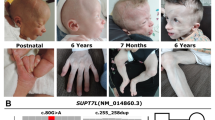Abstract
A novel human myosin gene located at 17q25 was identified through evaluation of genomic DNA sequence and designated myosin XVBP since it resembled human myosin XVA. In humans, myosin XVBP along with an adjacent gene, Lethal Giant Larvae 2 (LLGL2) appears to have arisen from a genomic duplication of a chromosomal interval that included LLGL and an ancestral myosin XV. Inspection of human myosin XVBP predicted amino acid sequence from genomic DNA revealed that 36 of the 131 conserved amino acid residues of the motor domain are substituted or deleted, including sequence changes within the regions involved in the binding of ATP and actin. Twelve myosin XVBP overlapping cDNAs from kidney and stomach mRNA samples were cloned and sequenced. Analyses of these myosin XVBP cDNAs revealed numerous additional disablements including translational reading frame shifts resulting in stop codons. From these data we conclude that myosin XVBP is a transcribed, unprocessed pseudogene.
Similar content being viewed by others
References
Baker JP and Titus MA (1998) Myosins: matching functions with motors. Curr Opin Cell Biol 10: 80–86.
Berg JS, Powell BC and Cheney RE (2001) A millennial myosin census. Mol Biol Cell 12: 780–794.
Cheney RE and Mooseker MS (1992) Unconventional myosins. Curr Opin Cell Biol 4: 27–35.
Cope MJ, Whisstock J, Rayment I and Kendrick-Jones J (1996) Conservation within the myosin motor domain: implications for structure and function. Structure 4: 969–987.
Friedman TB, Liang Y, Weber JL, Hinnant JT, Barber TD, Winata S, Arhya IN and Asher JH Jr. (1995) A gene for congenital, recessive deafness DFNB3 maps to the pericentromeric region of chromosome 17. Nat Genet 9: 86–91.
Friedman TB, Sellers JR and Avraham KB (1999) Unconventional myosins and the genetics of hearing loss. Am J Med Genet 89: 147–157.
Hattori M, Fujiyama A, Taylor TD, Watanabe H, Yada T, Park HS, Toyoda A, Ishii K, Totoki Y, Choi DK, Soeda E, Ohki M, Takagi T, Sakaki Y, Taudien S, Blechschmidt K, Polley A, Menzel U, Delabar J, Kumpf K, Lehmann R, Patterson D, Reichwald K, Rump A, Schillhabel M, Schudy A, Zimmermann W, Rosenthal A, Kudoh J, Schibuya K, Kawasaki K, Asakawa S, Shintani A, Sasaki T, Nagamine K, Mitsuyama S, Antonarakis SE, Minoshima S, Shimizu N, Nordsiek G, Hornischer K, Brant P, Scharfe M, Schon O, Desario A, Reichelt J, Kauer G, Blocker H, Ramser J, Beck A, Klages S, Hennig S, Riesselmann L, Dagand E, Haaf T, Wehrmeyer S, Borzym K, Gardiner K, Nizetic D, Francis F, Lehrach H, Reinhardt R and Yaspo ML (2000) The DNA sequence of human chromosome 21. Nature 405: 311–319.
Herberg JA, Beck S and Trowsdale J (1998) TAPASIN, DAXX, RGL2, HKE2 and four new genes (BING 1, 3-5) form a dense cluster at the centromeric end of the MHC. J Mol Biol 277: 839–857.
Hodge T and Cope MJ (2000) A myosin family tree. J Cell Sci 113: 3353–3354.
Houdusse A, Szent-Gyorgyi AG and Cohen C (2000) Three conformational states of scallop myosin S1. Proc Natl Acad Sci USA 97: 11,238–11,243.
Kendrick-Jones J, Hodge TP, Lister IMB, Roberts RC and Buss F (2001) Myosin Superfamily Review. From: The Myosin Home Page, www.mrclmb.cam.ac.uk/myosin/myosin.html
Kinose F, Wang SX, Kidambi US, Moncman CL and Winkelmann DA (1996) Glycine 699 is pivotal for the motor activity of skeletal muscle myosin. J Cell Biol 134: 895–909.
Liang Y, Wang A, Belyantseva IA, Anderson DW, Probst FJ, Barber TD, Miller W, Touchman JW, Jin L, Sullivan SL, Sellers JR, Camper SA, Lloyd RV, Kachar B, Friedman TB and Fridell RA (1999) Characterization of the human and mouse unconventional myosin XV genes responsible for hereditary deafness DFNB3 and shaker 2. Genomics 61: 243–258.
Mermall V, Post PL and Mooseker MS (1998) Unconventional myosins in cell movement, membrane traffic, and signal transduction. Science 279: 527–533.
Mighell AJ, Smith NR, Robinson PA and Markham AF (2000) Vertebrate pseudogenes. FEBS Lett 468: 109–114.
Mooseker MS and Cheney RE (1995) Unconventional myosins. Annu Rev Cell Dev Biol 11: 633–675.
Oliver TN, Berg JS and Cheney RE (1999) Tails of unconventional myosins. Cell Mol Life Sci 56: 243–257.
Patterson B, Ruppel KM, Wu Y and Spudich JA (1997) Cold-sensitive mutants G680V and G691C of Dictyostelium myosin II confer dramatically different biochemical defects. J Biol Chem 272: 27,612–27,617.
Probst FJ, Fridell RA, Raphael Y, Saunders TL, Wang A, Liang Y, Morell RJ, Touchman JW, Lyons RH, Noben-Trauth K, Friedman TB and Camper SA (1998) Correction of deafness in shaker-2 mice by an unconventional myosin in a BAC transgene. Science 280: 1444–1447.
Reilein AR, Rogers SL, Tuma MC and Gelfand VI (2001) Regulation of molecular motor proteins. Int Rev Cytol 204: 179–238.
Sellers JR (1999) Myosins. 2nd edn. Oxford University Press, Oxford.
Sellers JR (2000) Myosins: a diverse superfamily. Biochim Biophys Acta 1496: 3–22.
The May-Hegglin/Fechtner Syndrome Consortium (2000) Mutations in MYH9 result in the May-Hegglin anomaly and Fechtner and Sebastian syndromes. Nat Genet 26: 103–105.
Venter JC et al. (2001) The sequence of the human genome. Science 291: 1304–1351.
Wang A, Liang Y, Fridell RA, Probst FJ, Wilcox ER, Touchman JW, Morton CC, Morell RJ, Noben Trauth K, Camper SA and Friedman TB (1998) Association of unconventional myosin MYO15 mutations with human nonsyndromic deafness DFNB3. Science 280: 1447–1451.
Yamashita RA, Sellers JR and Anderson JB (2000) Identification and analysis of the myosin superfamily in Drosophila: a database approach. J Muscle Res Cell Motil 21: 491–505.
Author information
Authors and Affiliations
Rights and permissions
About this article
Cite this article
Boger, E.T., Sellers, J.R. & Friedman, T.B. Human myosin XVBP is a transcribed pseudogene. J Muscle Res Cell Motil 22, 477–483 (2001). https://doi.org/10.1023/A:1014507705858
Issue Date:
DOI: https://doi.org/10.1023/A:1014507705858




